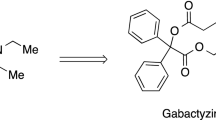Abstract
Seizures and status epilepticus, which may contribute to brain injury, are common consequences of exposure to organophosphorus (OP) cholinesterase inhibitors. Effective management of these seizures is critical. To investigate the efficacy of nasal midazolam as an anticonvulsive treatment for OP exposure, as compared to intramuscular midazolam, guinea pigs were connected to a recording swivel for electrocorticograph (ECoG) monitoring and clinical observation. The experimental paradigm consisted of pyridostigmine pretreatment (0.1 mg/kg i.m.) 20 min prior to sarin exposure (1.2× LD50, 56 µg/kg i.m.). One minute post-exposure, atropine (3 mg/kg i.m.) and TMB-4 (1 mg/kg im) were administered. Within 3–8 min after sarin exposure all animals developed electrographic seizure activity (EGSA), with convulsive behavior. Treatment with midazolam (1 mg/kg i.m.) 10 min after the onset of EGSA abolished EGSA within 389±181 s. The same dose was not effective, in most cases, when given 30 min after onset. However, a higher dose (2 mg/kg) was found efficacious after 30 min (949±466 s). In contrast, nasal application of midazolam (1 mg/kg) was found most effective, with significant advantages, in amelioration of EGSA and convulsive behavior, when given 10 min (216±185 s) or 30 min (308±122 s) following the onset of EGSA (P<0.001). Thus, nasal midazolam could be used as a novel, rapid and convenient route of application against seizure activity induced by nerve agent poisoning.






Similar content being viewed by others
References
Dunn MA, Sidell FR (1989) Progress in medical defense against nerve agents. JAMA 262:649–652
Einer-Jensen N, Khorooshi MH (2000) Cooling of the brain through oxygen flushing of the nasal cavities in intubated rats: an alternative model for treatment of brain injury. Exp Brain Res 130:244–247
Einer-Jensen N, Larsen L (2000a) Transfer of tritiated water, tyrosine, and propanol from the nasal cavity to cranial arterial blood in rats. Exp Brain Res 130:216–220
Einer-Jensen N, Larsen L (2000b) Local transfer of diazepam but not of cocaine from the nasal cavities to the brain arterial blood in rats. Pharmacol Toxicol 87:276–278
Giorgetti M, Bacciottini L, Giovannini MG, Colivicchi MA, Goldfarb J, Blandina P (2000) Local GABAergic modulation of acetylcholine release from the cortex of freely moving rats. Eur J Neurosci 12:1941–1948
Glenn JF, Hinman DJ, McMaster SB (1987) Electroencephalographic correlates of nerve agent poisoning. In: Dun NJ, Perlman RL (eds) Neurobiology of acetylcholine. Plenum Press, New York, pp 503–534
Koplovitz I, Skvorak JP (1998) Electrocorticographic changes during generalized convulsive status epilepticus in soman intoxicated rats. Epilepsy Res 30:159–164
Lahat E, Aladjem M, Eshel G, Bistritzer T, Katz Y (1992) Midazolam in treatment of epileptic seizures. Pediatr Neurol 8:215–216
Lahat E, Goldman M, Barr J, Eshel G, Berkovitch M (1998) Intranasal midazolam for childhood seizures. Lancet 352:620
Lemercier G, Carpentier P, Sentenac-Roumanou H, Morelis P (1983) Histological and histochemical changes in the central nervous system of the rat poisoned by an irreversible anticholinesterase organophosphorus compound. Acta Neuropathol 61:123–129
Lipp JA (1968) Cerebral electrical activity following soman administration. Arch Int Pharmacodyn Ther 175:161–169
McDonough JH, Shih TM (1993) Pharmacological modulation of soman-induced seizures. Neurosci Biobehav Rev 17:203–215
McDonough JH, Shih TM (1997) Neuropharmacological mechanisms of nerve agent-induced seizure and neuropathology. Neurosci Biobehav Rev 21:559–579
McDonough JH, McMonagle J, Copeland T, Zoeffel D, Shih TM (1999) Comparative evaluation of benzodiazepines for control of soman-induced seizures. Arch Toxicol 73:473–478
McLeod CG (1985) Pathology of nerve agents: perspectives on medical management. Fundam Appl Toxicol 5:S10–S16
Mcleod CG, Singer AW, Harrington DG (1984) Acute neuropathology in soman poisoned rats. Neurotoxicology 5:53–58
Moore DH, Clifford CB, Crawford IT, Cole GM, Baggett JM (1995) Review of nerve agent inhibitors and reactivators of acetylcholinesterase. In: Quinn DM, Balasubramanian AS, Doctor BP, Taylor P (eds) Enzymes of the cholinesterase family. Plenum Press, New York, pp 297–304
Parent JM, Lowenstein DH (1994) Treatment of refractory generalized status epilepticus with continuous midazolam infusion. Neurology 44:1837–1840
Pellock JM (1998) Use of midazolam for refractory status epilepticus in pediatric patients. J Child Neurol 13:581–587
Petras JM (1981) Soman neurotoxicity. Fundam Appl Toxicol 1:242
Philippens IHCHM, Melchers BPC, DeGroot DMG, Wolthius OL (1992) Behavioral performance, brain histology, and EEG sequela after immediate combined atropine/diazepam treatment of soman-intoxicated rats. Pharmacol Biochem Behav 42:711–719
Quadi M, Zia H, Needham TE (1999) Toxicological implications of nasal formulations. Drug Delivery 6:227–242
Rivera R, Segnini M, Battodumo A, Perez V (1993) Midazolam in the treatment of status epilepticus in children. Crit Care Med 21:991–994
Shih TM, Koviak TA, Capacio BR (1991) Anticonvulsants for poisoning by the organophosphorus compound soman: pharmacological mechanisms. Neurosci Biobehav Rev 15:349–362
Singer A, Jaax NK, Graham J (1987) Acute neuropathology and cardiomyopathy in soman and sarin intoxicated rats. Toxicol Lett 36:243–249
Tryphonas L, Clement JG (1995) Histomorphogenesis of soman-induced encephalocardiomiopathy in Sprauge-Dawley rats. Toxicol Pathol 23:393–409
Tryphonas L, Veinot JP, Clement JG (1996) Early histopathologic and ultrastructural changes in the heart of Sprauge-Dawley rats following administration of soman. Toxicol Pathol 243:190–198
Acknowledgements
Dr. E. Gilat would like to thank Dr. John H. McDonough, from the US Army Medical Research Institute of Chemical Defense, for his excellent advice and inspiration for these studies. The experiments comply with the current laws of the country in which the experiments were performed.
Author information
Authors and Affiliations
Corresponding author
Rights and permissions
About this article
Cite this article
Gilat, E., Goldman, M., Lahat, E. et al. Nasal midazolam as a novel anticonvulsive treatment against organophosphate-induced seizure activity in the guinea pig. Arch Toxicol 77, 167–172 (2003). https://doi.org/10.1007/s00204-002-0425-8
Received:
Accepted:
Published:
Issue Date:
DOI: https://doi.org/10.1007/s00204-002-0425-8




